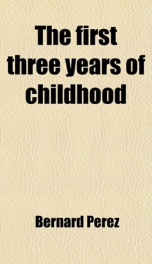the first three years of childhood

Purchase of this book includes free trial access to www.million-books.com where you can read more than a million books for free. This is an OCR edition with typos. Excerpt from book: have a special organ of sensibility to light. The automatic movements of the eyes, which are produced by mere irritation, without any sensation of light, contribute nevertheless to the nutrition of the muscular and nervous tissues, the development of which is indispensable to the production of visual sensibility. As the development of the muscles, the nerve centres, and the motor centres proceeds, as the sensations become distinct and the judgments more extended, the motor centres acquire more and more specialized powers of adjustment. A child of two months who can distinguish several objects outside himself, and is beginning to have a vague idea of distances, not being able to stretch out his hands and seize distant objects, as he does those near to him, bends his whole body towards them. At this same age children begin also to have a clearer idea of extent, or rather of localization relatively to the different parts of their bodies; they now only scratch themselves at intervals. Before the end of the third month, they begin to lift their hands to their faces oftener than before, and a little later the first pains of teething cause their fingers to be incessantly carried to the mouth. They now use their hands more and to better purpose ; the flexion of the hand from the wrist is accomplished perfectly ; the fingers have acquired more regular and more varied movements, and we notice efforts at stretching out the arms ; this, however, rarely as yet. A child at this age will also attempt movements of the legs and the thorax to balance himself in an upright position when held up on his feet, and will struggle with arms and knees to climb up to his nurse's face, when she helps him forward on his feet. In a word, he has gained greater consciousness and mastery of his activity; it...
Info about the book
Author:
Series:
Unknown
ISBN:
1178053350
Rating:
4.5/5 (4)Your rating:
0/5
Languge:
English
Users who have this book
Users who want this book
What readers are saying
What do you think? Write your own comment on this book!
write a commentGenre
if you like the first three years of childhood try:
Do you want to read a book that interests you? It’s EASY!
Create an account and send a request for reading to other users on the Webpage of the book!


